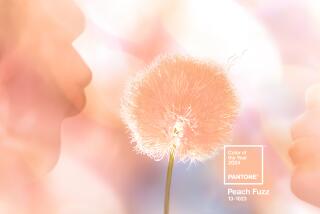Designers Are Forecasting More Daring and Brighter Colors
- Share via
Those who prefer the bland can rest assured that there will always be beige. But play-it-safe neutrals and monotone color decorating schemes are about to be superseded by more daring, brighter colors.
“We believe neutrals will be playing a supporting, not a stellar role,” said Vera Hahn, a designer who for the past eight years has been presiding over color forecasts made by DuPont Corp.
“We eliminated this year’s neutral range in our 1990 color forecast,” according to Deborah Hancock, color forecaster for Cotton Inc., the promotional arm of American cotton growers.
Next year’s recommendations by Cotton Inc. for basics around which to build a color scheme include some neutrals such as dark gray, a creamy off-white and straw. But they also encompass deep red as well as green, grayed purple and mauve.
As the two designers readily admitted on separate occasions, predicting color is definitely in the crystal ball category. Yet each year there is a surprising degree of unanimity among forecasters.
“That’s because we all look at the same products and same influences,” explained Hancock.
The purpose of predicting which way the color winds are blowing is to guide designers and manufacturers of home furnishings products, rather than to attempt to tell anybody what colors to choose, both said.
If forecasting colors is such an inexact science, why don’t a few color stylists simply meet in a back room and make their pronouncements each year?
For one thing, it just doesn’t work, said Hahn, noting that the unwritten pages of home furnishings history are filled with examples of color trends that failed, even though virtually every editor in the country promoted them.
“You can’t foist colors on American consumers. Therefore, I try to find out what consumers are ready to accept,” she said.
Hahn is not predicting a massive rejection of neutrals. On the contrary: “Neutrals are the workhorse colors of the home furnishings palette and low-contrast color schemes with pale, light colorations are easy to assemble, especially for amateurs. The effect their use creates is serene and relaxed. They make small rooms look larger.”
Useful though they are, however, she says neutrals and pale colors “are no longer on the cutting edge of newness.” And she, for one, is glad.
“If I have heard it once, I have heard it 11,574 times: ‘Let’s take beige, I won’t grow tired of it.’ That’s right--you won’t grow tired of beige, because after a while you will become totally unconscious of it and of your environment. Personally, I am not in favor of unconsciousness,” she said.
Schemes that glorify contrasts will replace bland low-contrast schemes.
“Lively colors, especially bright yellow, green and dark red shading to brown, will supply the tension between light and dark values that has been missing,” she added.
Hancock seemed to agree with Hahn by noting that “quite simply, the dusty, muted colors that have been the mainstay for the 1980s will be brighter and more intense in 1990.” She added that new color emphasis will be on green (especially a Granny Smith apple green), red (true red, ruby and rust) and yellow.
One reason for the appeal of stronger colors is that the currently popular decorating styles like Victorian, Art Deco, 1950s modern and some country styles call for them, said Hahn, adding that “our ancestors were more courageous in color than we are and they lived with schemes much longer.”
As for going out on a limb with actual color predictions, how do we know the experts are right? We don’t, admits Hahn. “But I’m a good guesser, and I have more nerve than brains.”
In fact, she bases her guesses on intuition honed by foreign and domestic travel, sales data from home furnishings stores around the country, magazine articles, even museum exhibits and ready-to-wear fads, both of which often trigger new style ideas for the home. Then she retires to a plain white room to allow all these influences to perk and brew in her thoughts.
Hancock said she had been startled to see that bright colors were dominant in cities as different as Frankfurt, London, Paris, Rome, New Delhi and Tokyo. She visited trade fairs and important shops in these cities in 1988 as part of her forecasting duties.
She found home furnishings products more daring both in intensity of color--such as tropical watermelon, jade and orange--and in mixing several colors in a single fabric.
The purpose of traveling afar is that many American home furnishings colors originate in places such as Paris, Italy and now increasingly Japan, said Hancock.
Apparel also sparks new ideas. But it’s not a one-way street.
Hancock says U.S. fashions are influencing foreign color trends and home furnishings are affecting apparel. After all, floral chintz, cabbage roses and tapestry fabrics that have become popular in apparel all started out as home furnishings fabrics.


